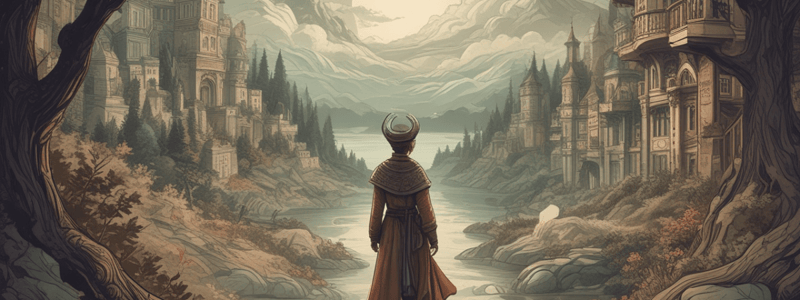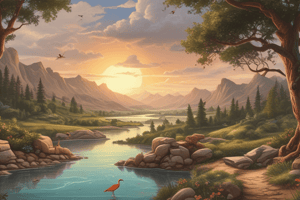Podcast
Questions and Answers
What are the components of a literary work?
What are the components of a literary work?
- setting, plot, characters, and conflict
- characters, conflict, theme, and point of view
- plot, characters, theme, and conflict
- setting, plot, characters, and theme (correct)
Why is conflict considered an important literary element?
Why is conflict considered an important literary element?
- it makes the story more relatable
- it adds humor to the story
- it is the struggle between two forces (correct)
- it makes the story more boring
What type of conflict occurs within a character?
What type of conflict occurs within a character?
- External conflict
- Literal conflict
- Internal conflict (correct)
- Imaginary conflict
What is the role of characters in a story?
What is the role of characters in a story?
Which of the following is an example of external conflict?
Which of the following is an example of external conflict?
Why are stories engaging?
Why are stories engaging?
What are the two main roles in a story?
What are the two main roles in a story?
What is the main conflict in a story typically between?
What is the main conflict in a story typically between?
What is the climax of a story?
What is the climax of a story?
What does the setting of a story include?
What does the setting of a story include?
What is the theme of a story?
What is the theme of a story?
How does the conflict affect the plot?
How does the conflict affect the plot?
What is the resolution of a story?
What is the resolution of a story?
How does the social situation of the setting affect the story?
How does the social situation of the setting affect the story?
What is the purpose of conflict in a story?
What is the purpose of conflict in a story?
Flashcards are hidden until you start studying
Study Notes
Literary Elements
- Literary elements are the components of a literary work, including setting, plot, characters, and theme.
- Conflict is arguably the most important literary element, as it is the struggle between two forces that makes a story intriguing.
Types of Conflict
- External conflict occurs between two characters or between a character and a natural force.
- Internal conflict occurs within one character, such as a character's inner struggle or dilemma.
Characters
- Characters are people, animals, or figures featured in a story, and are essential for conflict to exist.
- Every story has a protagonist (good guy) and an antagonist (bad guy), with the main conflict being a struggle between these two characters.
- Examples of protagonists and antagonists include Harry Potter and Voldemort, and Katniss and President Snow.
Plot
- The plot is the series of events in a story, consisting of:
- Exposition: introduces characters, setting, and conflict
- Rising action: builds up suspense
- Climax: turning point in the story
- Falling action: suspense lessens and story approaches the end
- Resolution: conflict is resolved and loose ends are tied
- Conflict plays a role in each part of the plot.
Setting
- Setting is the time, place, and social situation in which a story takes place.
- Time consists of when the story occurs, place is the location, and social situation is any important event in society during the story.
- Setting drastically affects the conflict, as different settings can change the entire plot and characters' experiences.
Theme
- Theme is the central message or lesson learned from a story, and can be multiple in a single story.
- Conflict is often used to emphasize themes, and authors create conflicts to put emphasis on these themes.
- Examples of themes include death, morality, and good vs. evil.
Studying That Suits You
Use AI to generate personalized quizzes and flashcards to suit your learning preferences.




